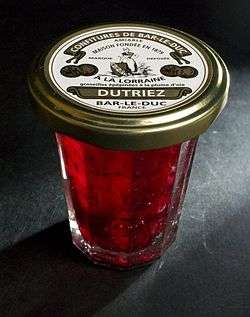Bar-le-duc jelly
|
A jar of red currant jam | |
| Type | Spread |
|---|---|
| Place of origin | France |
| Region or state | Bar-le-duc |
| Main ingredients | Currants (white currants or red currants) |
|
| |
Bar-le-duc jelly (French pronunciation: [baʁ lə dyk]) is a highly regarded preparation of jelly originally composed of select whole seeded currants, typically white currants or alternatively red currants. The name Bar-le-duc refers to the geographical origin of the preparation in the French town of Bar-le-duc. Since the jelly's first documented reference in 1344, the culinary name "Lorraine Jelly" is occasionally used, as the city of Bar-le-duc lies within the boundaries of the former province of Lorraine.
Commonly served as an accompaniment to game, spread on bread, or with foie gras, it is considered a culinary luxury, sharing an elite status akin to Beluga caviar and is colloquially referred to as Bar Caviar. The typical product is a jam, with the berries remaining intact in a thin syrup. About 200 currants go into one 85 gram jar (approximately 3 ounces), which costs approximately €15 a jar in Bar-le-Duc and $40 in the US (as of 2008). The spread has been enjoyed by notables such as Alfred Hitchcock, Ernest Hemingway, Victor Hugo, and Mary, Queen of Scots.
Examples
As of 2012 the House of Dutriez in the town of Bar-le-Duc provides one of the very few hand-made preparations still on the market, la confiture de Groseilles de Bar le Duc (Currant Preserve). The traditionally hand-made product involves épépineurs or épépineuses (seed extractors) de-seeding the currants with goose quills to flick out the tiny seeds without disturbing the flesh of the small fruit. Sometimes sweetened jellies, consisting of mashed and sieved currants of a significantly lower cost and quality, appear on the market under the same name.[1]
When Rex Stout's fictional detective Nero Wolfe deals with the distraught daughter of his bootblack in Kill Now—Pay Later, he suspects hunger, as much as the shock of her father's death, is responsible for her emotional instability, and tells his cook “Tea with honey, Fritz. Toast, pot cheese, and Bar-le-Duc. For Miss Vassos,” strengthening Wolfe's reputation as a gourmet and establishing the high regard in which he regarded her father.
See also
Notes
- ↑ "A Jam Fit for a Queen, Dutriez Bar-Le-Duc". FXcuisine. Archived from the original on 26 March 2014. Retrieved 15 February 2013.
References
- Barry, Ann. Bar-Le-Duc Currant Preserves. The New York Times : Arts and Leisure Section. January 30, 1983.
- Anon. Royal Jelly. Waitrose. February 2000
- Anon. Homepage of Bar-le-Duc France, Delights and Traditions, in English Ville de Bar-le-duc, France. August 2009.
External links
- House of Dutriez Confitures à la Lorraine (House of Dutriez).
- Homepage of the City of Bar-le-duc, France, in French.
![]() This article incorporates text from a publication now in the public domain: Ward, Artemas (1911). The Grocer's Encyclopedia.
This article incorporates text from a publication now in the public domain: Ward, Artemas (1911). The Grocer's Encyclopedia.
